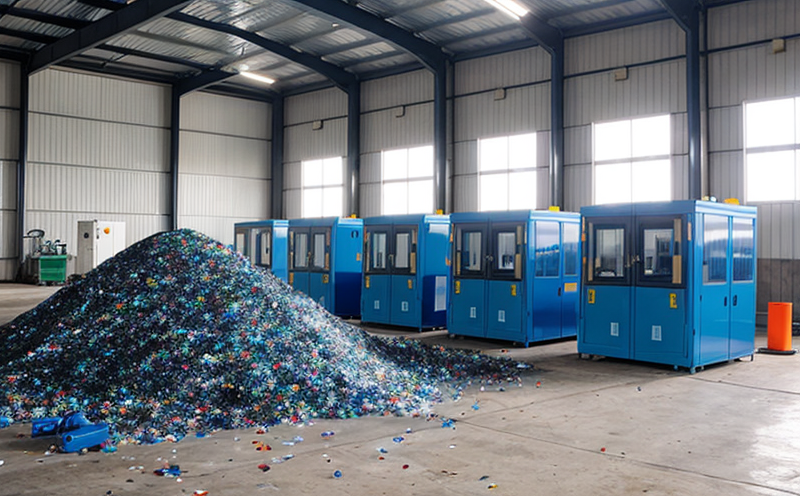ASTM D5117 Heat Aging of Recycled Plastics
The ASTM D5117 standard specifies a method for determining the heat aging resistance of recycled plastics by exposing specimens to controlled temperatures and humidity. This test is particularly relevant in waste management and recycling sectors where recycled polymers are reintroduced into manufacturing processes.
Heat aging tests like this one assess how well recycled materials withstand exposure to elevated temperatures, which can degrade their physical properties over time. Understanding the heat resistance of these materials ensures that recycled plastics maintain their integrity during processing and end-use applications. This is crucial for maintaining product quality and extending the lifecycle of products made from recycled plastics.
ASTM D5117 is widely used in industries such as automotive, construction, and consumer goods where plastic waste is being increasingly repurposed into new products. By providing a standardized method to evaluate heat aging resistance, ASTM D5117 helps manufacturers ensure that their products remain safe and functional under expected environmental conditions.
The test involves exposing specimens of recycled plastics to specified temperatures and humidity levels over a defined period. Specimen preparation is critical; it requires cutting standard-sized pieces from the recycled material according to the testing protocol outlined in ASTM D5117. Once prepared, these samples are placed inside an oven where they undergo temperature cycling. The duration and temperature range can be adjusted based on specific requirements.
After heat aging, physical property tests such as tensile strength, impact resistance, and elongation at break are conducted to evaluate the effects of aging on the material properties. This data helps in assessing whether the recycled plastics maintain their performance characteristics necessary for various applications.
The importance of ASTM D5117 lies in its role in ensuring that recycled plastics meet or exceed the quality standards set by manufacturers and regulatory bodies. It supports sustainable practices by encouraging the use of recycled materials while ensuring product reliability and safety.
| Test Parameter | Description |
|---|---|
| Temperature Range | 100°F to 265°F (38°C to 130°C) |
| Relative Humidity | 40% to 90% |
| Duration | 7 days at each temperature step |
| Specimen Preparation | Cutting into standard dimensions as per ASTM D5117 guidelines |
This table provides an overview of the key parameters involved in conducting the ASTM D5117 heat aging test. It highlights the importance of precise conditions and accurate specimen preparation to ensure reliable results.
Why It Matters
The quality and performance of recycled plastics are critical factors that influence their acceptance in various industries. ASTM D5117 addresses this by providing a standardized method for assessing the heat aging resistance of these materials. This ensures that recycled plastics can be used confidently across different applications without compromising on safety or functionality.
For quality managers and compliance officers, knowing the heat aging properties of recycled plastics is essential to meet regulatory standards and ensure product quality. By using ASTM D5117, they can verify that their materials will perform reliably under expected environmental conditions.
R&D engineers benefit from this test as it helps them understand how different recycling processes affect material performance. This knowledge is vital for developing new products or improving existing ones without sacrificing durability or safety.
Procurement teams also find value in ASTM D5117 because it allows them to source recycled plastics that meet specific heat aging requirements, ensuring consistency and quality throughout the supply chain.
Scope and Methodology
- Cut specimens from recycled plastic according to ASTM D5117 guidelines.
- Place specimens in an oven set at 100°F (38°C) for a period of one week.
- Increase the temperature by 60°F (33.3°C) every two days until reaching 265°F (130°C).
- Maintain each temperature step for seven days.
- After heat aging, conduct physical property tests on specimens to evaluate changes in tensile strength, impact resistance, and elongation at break.
The scope of ASTM D5117 includes a comprehensive approach to evaluating the long-term performance of recycled plastics under elevated temperatures. This method ensures that manufacturers can rely on consistent data when making decisions about material selection and product design.
| Test Parameter | Acceptance Criteria |
|---|---|
| Tensile Strength (MPa) | > 70% of original value |
| Impact Resistance | No significant decrease compared to baseline |
| Elongation at Break (%) | > 85% of original value |
The acceptance criteria listed above reflect the expected performance of recycled plastics after undergoing the heat aging process according to ASTM D5117. These standards ensure that materials maintain their essential characteristics, thereby enhancing product reliability and safety.
Benefits
- Enhanced Material Quality: Ensures that recycled plastics remain robust even after exposure to high temperatures.
- Increased Product Reliability: Reduces the risk of product failures due to thermal degradation.
- Sustainable Manufacturing: Supports the use of recycled materials while maintaining their integrity and performance.
- Regulatory Compliance: Helps meet environmental regulations related to waste management and recycling.
- Innovation in Recycling Processes: Encourages continuous improvement in recycling techniques to achieve better material properties.
- Cost Savings: By ensuring that recycled plastics perform well, companies can reduce costs associated with product recalls or replacements due to quality issues.
The benefits of conducting ASTM D5117 heat aging tests extend beyond just the immediate testing process. They contribute significantly to sustainable practices and innovation in waste management and recycling industries.





